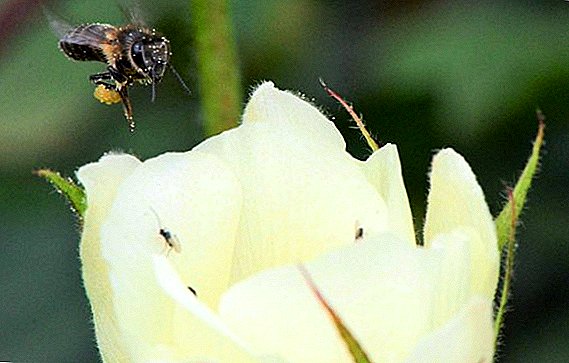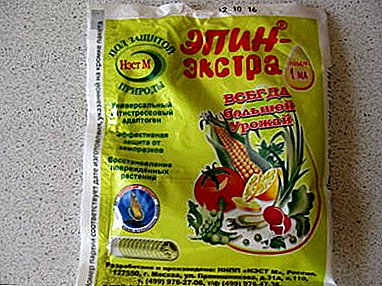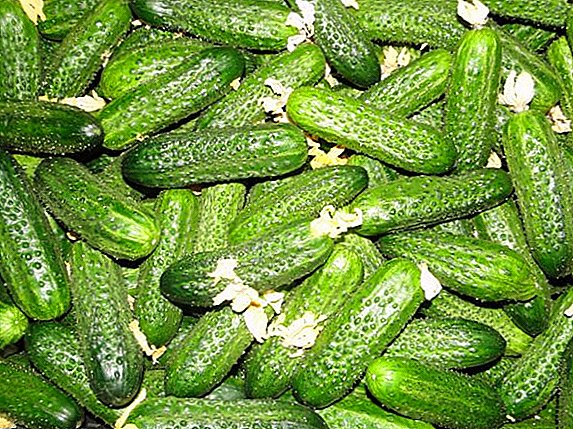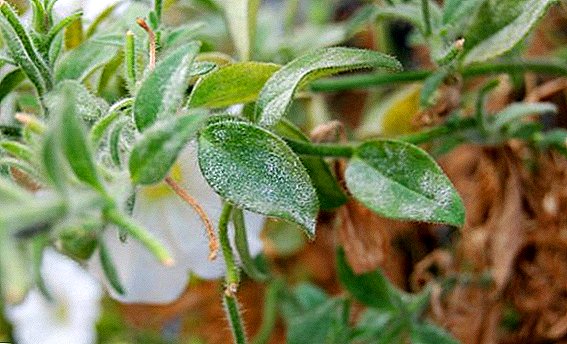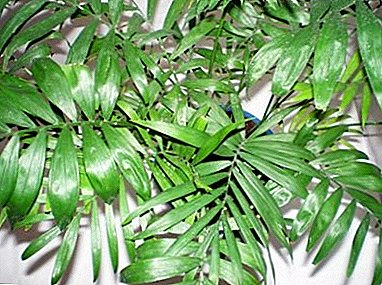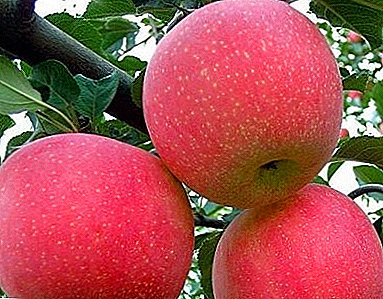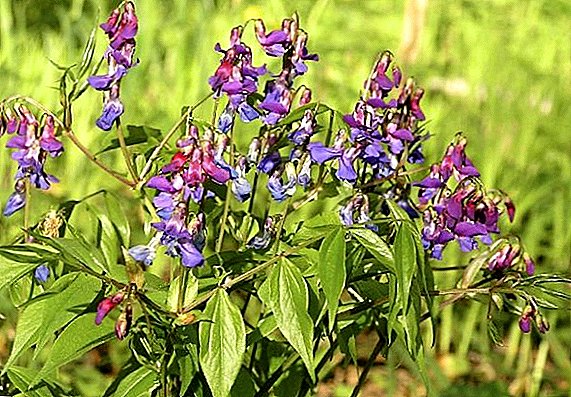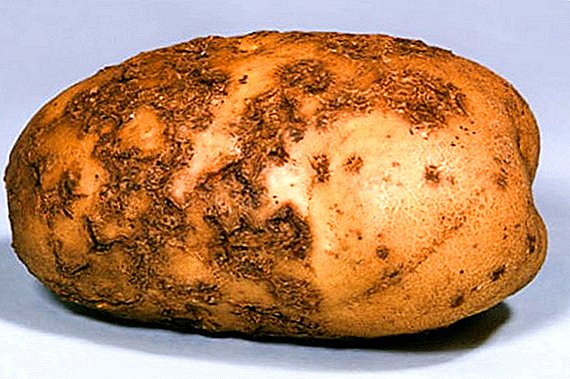 Potatoes - this is one of the most popular, beloved by many vegetables, which can be found in everyone in the garden. But, like other cultures, it is exposed to diseases that spoil its appearance and degrade its taste. The most common of these is scab. Next, we will learn more about scab on potatoes: with her photo, description and methods of treatment, with what to do to prevent its occurrence.
Potatoes - this is one of the most popular, beloved by many vegetables, which can be found in everyone in the garden. But, like other cultures, it is exposed to diseases that spoil its appearance and degrade its taste. The most common of these is scab. Next, we will learn more about scab on potatoes: with her photo, description and methods of treatment, with what to do to prevent its occurrence.
Why appears
The reasons for the appearance of scab on potatoes can be several:
- often the disease falls on tubers from the ground;
- also the source of the disease may be the infected new tubers that you purchased for planting;
- a common cause is the annual planting of a crop at the same place;
- an excessive amount of nitrogen favorably affects the development of fungal scab disputes;
- contributes to the development of the disease high temperature of the soil (from 20 ° C);
- the fungus develops rapidly in subacid soils;
- improper use of natural fertilizers such as manure and compost.

Important! Manure and compost, which will be applied to the soil, must be rotten.
This disease does not pose any danger to humans, affected roots can be eaten, but the nutritional value of such vegetables is much lower than healthy ones. For example, infected tubers have a 2-fold lower starch level.
In addition, these tubers are very poorly stored, they quickly develop rot, and often have to throw out most of the crop.
Even if you are lucky and the infected potatoes are successfully nicknamed, it is strictly forbidden to plant them in the ground, because you will definitely get an unhealthy crop and infect the soil with fungus.
Late blight (or brown rot) is also among the most common potato diseases.
Forms of scab and signs of damage
There are several forms of this disease: common scab, powdery, black (or rhizoctoniosis), silver. And we will get to know each of them in more detail.
Ordinary - this disease begins to develop successfully in soils with low or medium levels of acidity, when the temperature of the soil ranges from 25 ° C to 30 ° C, and with a lack of watering. If liming was performed on your site, then this increases the likelihood of this disease.
Also, the pathogen may appear on the remains of potatoes that have not been harvested. Because of this, in the future, in the presence of favorable conditions, the fungus can easily get over to healthy tubers through even the most minor mechanical damage to the skin. 
Important! If during storage you accidentally mix healthy and sick potatoes together, then it is not dangerous - scab spreads only in the ground.
With this disease, only the plant tubers are exposed. The scab can be identified by such signs as the presence of ulcers of irregular shape, which with the growth of the root, too, grow, and over time harden.
Sometimes cracks appear on the affected areas. There are cases when the potato is completely covered with such ulcers. These lesions contribute to the appearance of various types of rot.
Powdery - this type of scab appears as a result of exposure to a fungus that moves independently; it looks like a small lump of mucus. In this case, the entire underground part of the plant is infected.
Outwardly, this scab looks like the tubers are covered with a huge number of "warts". After the potatoes are dug, these “warts” dry out a lot, burst and form ulcers that contain the spores of the fungus. On the roots, it can appear as small white growths.  Powder scab may appear due to contaminated manure, soil, planting material. Favorable effect on its development is wet land and temperature from 12 ° C to 20 ° C. Very often, this type of disease appears in heavy soil.
Powder scab may appear due to contaminated manure, soil, planting material. Favorable effect on its development is wet land and temperature from 12 ° C to 20 ° C. Very often, this type of disease appears in heavy soil.
Did you know? Scab - very tenacious disease, its disputes can live in the ground for several years. Therefore, in the infected areas, potatoes can not be planted for about 5 years.
Black (Rhizoctoniosis) - This form is very dangerous for the plant, because it infects the plant from the roots to the leaves. Risoctoniosis in the early stages of the life of new potatoes can inhibit the growth of stems, as well as completely kill the whole shrub.
Externally, rhizoctoniosis is manifested by dark spots completely covering the surface of root crops. The ideal conditions for the development of fungus is considered to be high humidity and a temperature not lower than 18 ° C.  Silvery - the main distinctive feature of this form is that the tubers affected by it during storage do not rot, but only dry out and lose weight. The peel is wrinkled, and in some places a grayish shiny patina appears.
Silvery - the main distinctive feature of this form is that the tubers affected by it during storage do not rot, but only dry out and lose weight. The peel is wrinkled, and in some places a grayish shiny patina appears.
Such lesions are clearly visible on varieties with reddish skin. This species of scab appears on vegetables that are grown in sandy loam and loamy soil, subject to elevated temperatures during the formation and formation of young tubers.
It also appears at elevated humidity of more than 90% and at temperatures below 10 ° C. 
Prevention
Each of the forms of the disease that we have examined has different pathogens, but regardless of this, in any case, we get a spoiled crop and an infected area.
Even when you have never noticed a scab on your potatoes, this does not mean that you can relax, because the disease can appear anytime. Any form of the disease can be overcome, but the harvest will still be partially spoiled, so the best thing you can do is do prevention.
One of the effective methods of prevention is considered preplant treatment seed. For planting, you need to select the healthiest potatoes and pickle them. For these purposes, apply a huge number of drugs that you can buy at any gardening shop.
Did you know? Potatoes can be attacked by more than 20 different diseases.
It is also recommended to water the bushes with copper, manganese and boron after planting after planting. This measure significantly reduces the likelihood of the disease, as well as reduces the infectiousness of already sick root crops.
Agrotechnical receptions
Agrotechnical measures to prevent the appearance of potato scab are no less important than the choice of high-quality seed.
The first thing to adhere to is the annual change of the vegetable planting site. Planting potatoes need to alternate with the planting of legumes or onions.
If the soil on the site where you grow potatoes, alkaline, then it must be acidified. To do this, use a special solution that is prepared as follows: 2 spoons of ammonium sulfate is dissolved in 10 liters of water. This solution is necessary to water flowering plants at the rate of 0.5 liters per bush.
One and a half or two weeks before harvesting, it is recommended to mow the entire above-ground part — this procedure will help strengthen the skin of the roots.  After the crop has been harvested, it is strongly recommended to plant the site with any sideratom. Siderat promotes fertilizer and soil healing. For this purpose, you can plant rye, wheat, legumes, mustard, canola, or you can sow the mixture.
After the crop has been harvested, it is strongly recommended to plant the site with any sideratom. Siderat promotes fertilizer and soil healing. For this purpose, you can plant rye, wheat, legumes, mustard, canola, or you can sow the mixture.
In this case, it is very important to mow siderats in time. This should be done before their flowering, because during flowering they "suck" many nutrients and cease to be fertilizers.
Preparations against scab
Many gardeners who were unable to prevent the emergence of the disease, are wondering how to heal the land to get rid of scab on potatoes. In order to get rid of the scab, use a variety of drugs, and with some we will look further.
Given the reviews of gardeners on various sites and forums, in the fight against rhizoctoniosis, as well as with many other fungal diseases, 1% solution of copper sulfate, which is sprayed with bushes, has worked well.
Important! Copper sulfate is used only for spraying bushes. It is strictly forbidden to work the soil, because copper belongs to heavy metals and poisons the soil.
 Well inhibits the development of potato scab drug "Circo." It should be used at the time of the appearance of buds. Even if you treat the plant with this drug once, it will help you get a richer and healthier crop.
Well inhibits the development of potato scab drug "Circo." It should be used at the time of the appearance of buds. Even if you treat the plant with this drug once, it will help you get a richer and healthier crop.Equally effective is the drug "Phyto Plus". They should treat the planting material and spray the bushes during the growing season, it reduces the extent of tuber disease. Make a solution at the rate of 1 sachet per 3 liters.
Fludioksonil "Maxim" well helps in the fight against all forms of scab. It is used both for the treatment of seed and directly to the bushes. The solution for both purposes is prepared at the rate of 20 ml of the substance per 1 liter of water.
Typically, a centner of potato is enough 1.5 liters of solution. Root crops are processed before storage and before planting. 
Resistant varieties
If neither preventive or curative measures help, there is a need to replace vegetable varieties. Although there are no varieties that are completely resistant to this disease, you can choose those that resist scab; accordingly, it has a less detrimental effect on them.
These varieties include the following varieties: Aspia, Bryansk New, Vilna, Lyubimets, Alpha, Saturn, Rodnik, Ostara, Lady Rosetta, Mentor, "Nicolas", "Devoted" and others.  In order for the scab to bypass your potato crop, it is not enough to choose a variety resistant to it. It is very important to pay special attention to the choice of seed and to observe all preventive measures.
In order for the scab to bypass your potato crop, it is not enough to choose a variety resistant to it. It is very important to pay special attention to the choice of seed and to observe all preventive measures.


